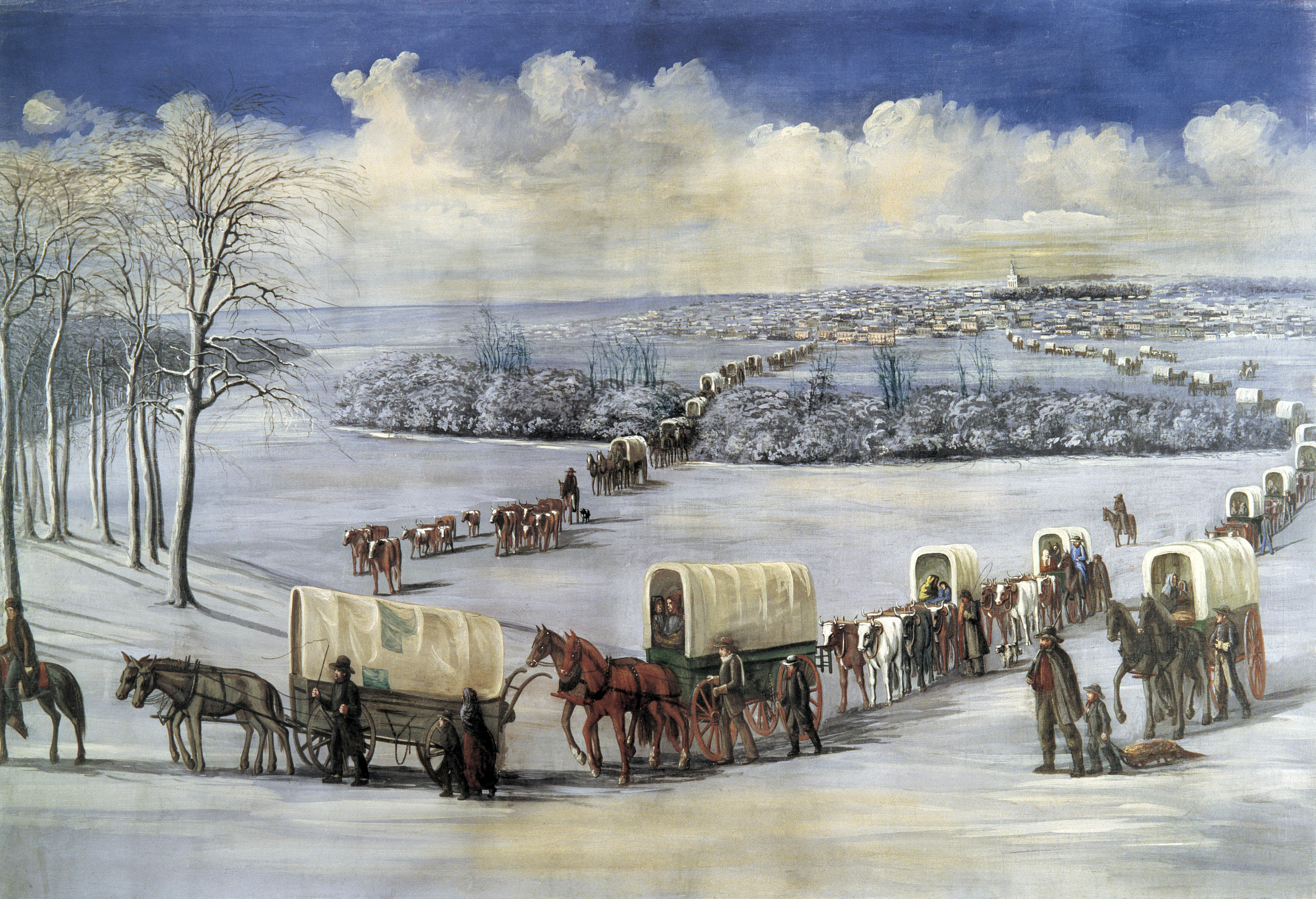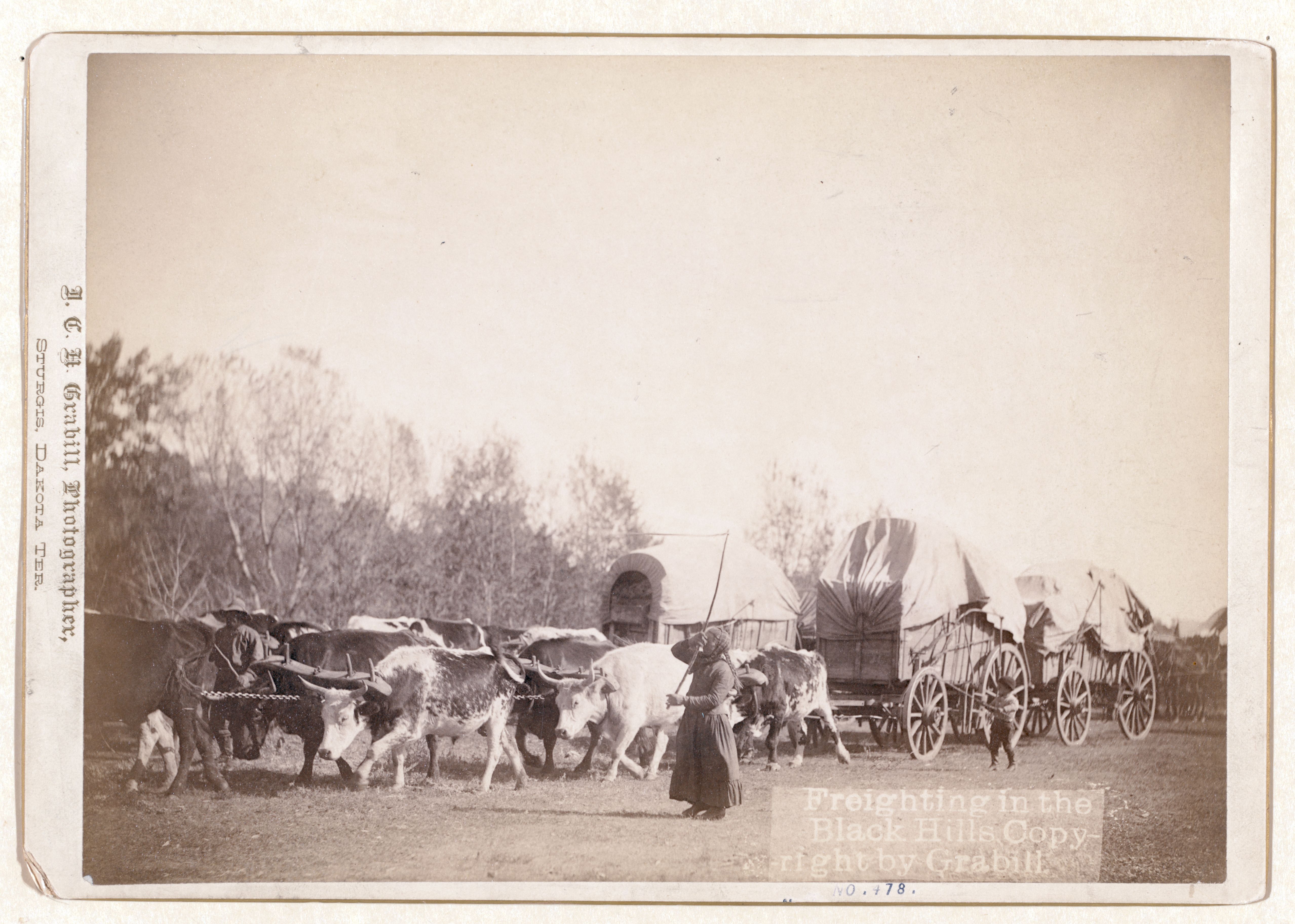Covered Wagons on:
[Wikipedia]
[Google]
[Amazon]

 A covered wagon, also called a prairie wagon, whitetop, or prairie schooner, is a horse-drawn or ox-drawn
A covered wagon, also called a prairie wagon, whitetop, or prairie schooner, is a horse-drawn or ox-drawn
File:Smithsonian National Museum of American History - Conestoga Wagon (8307591214).jpg , Conestoga at
File:Covered Wagon (7515047658).jpg , Covered wagon at
File:Burchell wagon00.jpg, Diagram of wagon and fittings
File:Opnamen FF-tentoonstelling te Enschede. Een Transvaalse boer met een huifkar get, Bestanddeelnr 904-7345.jpg, Almost exclusively pulled by oxen
File:Kruger House Church Street Pretoria 049.jpg, Voortrekker wagon in museum
 Before railroads in early America, ox-teams and wagons were used to haul overland freight, sometimes in great
Before railroads in early America, ox-teams and wagons were used to haul overland freight, sometimes in great

 A covered wagon, also called a prairie wagon, whitetop, or prairie schooner, is a horse-drawn or ox-drawn
A covered wagon, also called a prairie wagon, whitetop, or prairie schooner, is a horse-drawn or ox-drawn wagon
A wagon (or waggon) is a heavy four-wheeled vehicle pulled by Working animal#Draft animals, draft animals or on occasion by humans, used for transporting goods, commodities, agricultural materials, supplies and sometimes people.
Wagons are i ...
used for passengers or freight hauling. It has a canvas, tarpaulin, or waterproof sheet which is stretched over removable wooden bows (also called hoops or tilts) and lashed to the body of the wagon. They were a popular style of vehicle for overland migrations.
Conestoga wagon
TheConestoga wagon
The Conestoga wagon, also simply known as the Conestoga, is a horse-drawn freight wagon that was used exclusively in North America, primarily the United States, in the 18th and 19th centuries. Such wagons were probably first used by Pennsylvania ...
was a heavy American wagon of English and German type from the late 18th century and into the 19th century. It was used for freight and drawn by teams of horses or oxen depending on load. The covered canvas top was supported on eight to twelve angled bows, rather than upright. Capacity was around 4 to 5 tons with no springs. Though it was boat-shaped it did not float. It was used in eastern North America for freight hauling, with some used for southward migration through the Appalachian valleys and along the Great Wagon Road
The Great Wagon Road, also known as the Philadelphia Wagon Road, is a historic trail in the eastern United States that was first traveled by indigenous tribes, and later explorers, settlers, soldiers, and travelers. It extended from British Penn ...
. It was too heavy for use west of the Mississippi River
The Mississippi River is the main stem, primary river of the largest drainage basin in the United States. It is the second-longest river in the United States, behind only the Missouri River, Missouri. From its traditional source of Lake Ita ...
; the westward wagons were lighter, and more angular or square.
National Museum of American History
The National Museum of American History: Kenneth E. Behring Center is a historical museum in Washington, D.C. It collects, preserves, and displays the heritage of the United States in the areas of social, political, cultural, scientific, and m ...
File:Conestoga Wagon - Museum of Science and Industry (Chicago) - DSC06717.JPG, Shows framework at Museum of Science and Industry
File:A historic conestoga wagon LCCN2012645747.jpg, Freight Conestoga (Pennsylvania)
America westward expansion
With roots in the heavyConestoga wagon
The Conestoga wagon, also simply known as the Conestoga, is a horse-drawn freight wagon that was used exclusively in North America, primarily the United States, in the 18th and 19th centuries. Such wagons were probably first used by Pennsylvania ...
developed for the rough, undeveloped roads and paths of the colonial East, the covered wagon spread west with American migration. Typical farm wagons were merely covered for westward expansion and heavily relied upon along such travel routes as the Great Wagon Road
The Great Wagon Road, also known as the Philadelphia Wagon Road, is a historic trail in the eastern United States that was first traveled by indigenous tribes, and later explorers, settlers, soldiers, and travelers. It extended from British Penn ...
, Mormon Trail
The Mormon Trail is the route from Illinois to Utah on which Mormon pioneers (members of the Church of Jesus Christ of Latter-day Saints) traveled from 1846 to 1869. Today, the Mormon Trail is a part of the United States National Trails Syst ...
, Santa Fe Trail
The Santa Fe Trail was a 19th-century route through central North America that connected Franklin, Missouri, with Santa Fe, New Mexico. Pioneered in 1821 by William Becknell, who departed from the Boonslick region along the Missouri River, the ...
, and Oregon Trail
The Oregon Trail was a east–west, large-wheeled wagon route and Westward Expansion Trails, emigrant trail in North America that connected the Missouri River to valleys in Oregon Territory. The eastern part of the Oregon Trail crossed what ...
, covered wagons carried settlers seeking land, gold, and new futures ever farther west.
Once breached, the moderate terrain and fertile land between the Appalachians and the Mississippi was rapidly settled. In the mid-nineteenth century thousands of Americans took a wide variety of farm wagon
A wagon (or waggon) is a heavy four-wheeled vehicle pulled by Working animal#Draft animals, draft animals or on occasion by humans, used for transporting goods, commodities, agricultural materials, supplies and sometimes people.
Wagons are i ...
s across the Great Plains
The Great Plains is a broad expanse of plain, flatland in North America. The region stretches east of the Rocky Mountains, much of it covered in prairie, steppe, and grassland. They are the western part of the Interior Plains, which include th ...
from developed parts of the Midwest to places in the West such as California, Oregon, Utah, Colorado, and Montana. Overland migrants typically fitted any sturdy wagon with several wooden or metal bows which arched high over the bed. Over this was stretched canvas
Canvas is an extremely durable Plain weave, plain-woven Cloth, fabric used for making sails, tents, Tent#Marquees and larger tents, marquees, backpacks, Shelter (building), shelters, as a Support (art), support for oil painting and for other ite ...
or similar sturdy cloth, creating the distinctive covered wagon silhouette.
For "overlanders" migrating westward, covered wagons were a more common mode of transportation than wheelbarrow, stagecoach, or train. Oxen
An ox (: oxen), also known as a bullock (in BrE, British, AusE, Australian, and IndE, Indian English), is a large bovine, trained and used as a draft animal. Oxen are commonly castration, castrated adult male cattle, because castration i ...
were the most common draft animal for pulling covered wagons, although mule
The mule is a domestic equine hybrid between a donkey, and a horse. It is the offspring of a male donkey (a jack) and a female horse (a mare). The horse and the donkey are different species, with different numbers of chromosomes; of the two ...
s and horse
The horse (''Equus ferus caballus'') is a domesticated, one-toed, hoofed mammal. It belongs to the taxonomic family Equidae and is one of two extant subspecies of ''Equus ferus''. The horse has evolved over the past 45 to 55 mi ...
s were also used. Authors of guidebooks written for emigrants noted that oxen were more reliable, less expensive, and nearly as fast as other options.
Pipe Spring National Monument
Pipe Spring National Monument is a United States National Monument located in the U.S. state of Arizona, rich with American Indian, early explorer, and Mormon pioneer history. Administered by the National Park Service, Pipe Spring was list ...
File:Drawing, A Covered Wagon, 1870–80 (CH 18369129).jpg , Covered wagon c. 1870s
File:`Drawing, Study, Covered Wagons, possibly 1871 (CH 18369111).jpg , Covered wagons c. 1871
Prairie schooner
''Prairie schooner'' is a fanciful name for the covered wagon, drawing on their broad white canvas covers, romantically envisioned as the sails of a ship crossing the sea of prairie grass.South Africa Great Trek
During theGreat Trek
The Great Trek (, ) was a northward migration of Dutch-speaking settlers who travelled by wagon trains from the Cape Colony into the interior of modern South Africa from 1836 onwards, seeking to live beyond the Cape's British colonial adminis ...
starting in 1836, Dutch-speaking settlers in South Africa travelled by wagon train
''Wagon Train'' is an American Western television series that aired for eight seasons, first on the NBC television network (1957–1962) and then on ABC (1962–1965). ''Wagon Train'' debuted on September 18, 1957, and reached the top of the ...
s, migrating northward from British-ruled areas in search of their own homeland. Mostly pulled by pairs of oxen, the Boer trek wagon had a long wheel-base with the sides higher at the rear in typical Dutch fashion. The wagon had a felt or canvas top supported by bowed hoops.
Freight
 Before railroads in early America, ox-teams and wagons were used to haul overland freight, sometimes in great
Before railroads in early America, ox-teams and wagons were used to haul overland freight, sometimes in great wagon trains
''Wagon Train'' is an American Westerns on television, Western television series that aired for eight seasons, first on the NBC television network (1957–1962) and then on American Broadcasting Company, ABC (1962–1965). ''Wagon Train'' debute ...
of 10 to 60 teams. Each team of 5 to 7 yoked pairs of oxen pulled two wagons—a lead wagon (averaging ), which pulled a trailer wagon ().
Military have used covered wagons for transport of supplies. Called "baggage wagons" during the American Revolutionary War
The American Revolutionary War (April 19, 1775 – September 3, 1783), also known as the Revolutionary War or American War of Independence, was the armed conflict that comprised the final eight years of the broader American Revolution, in which Am ...
, in one account British commander Henry Clinton had a baggage train of 1,500 wagons that stretched 12 miles long.
See also
*Ox-wagon
An ox-wagon or bullock wagon is a four-wheeled vehicle pulled by oxen (draught cattle). It was a traditional form of transport, especially in Southern Africa but also in New Zealand and Australia. Ox-wagons were also used in the United States. ...
* Vardo (Romani wagon)
A vardo (also Romani wag(g)on, Gypsy wagon, living wagon, caravan, van and house-on-wheels) is a four-wheeled horse-drawn vehicle traditionally used by travelling Romanichal as their home. The name ''vardo'' is a Romani language, Romani term bel ...
* Wagon
A wagon (or waggon) is a heavy four-wheeled vehicle pulled by Working animal#Draft animals, draft animals or on occasion by humans, used for transporting goods, commodities, agricultural materials, supplies and sometimes people.
Wagons are i ...
References
External links
* {{Authority control American frontier Demographic history of the United States History of United States expansionism History of road transport Wagons